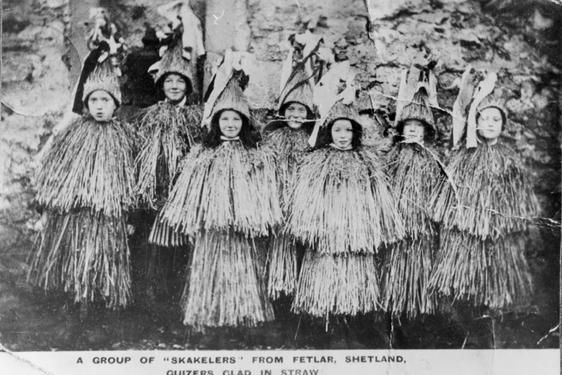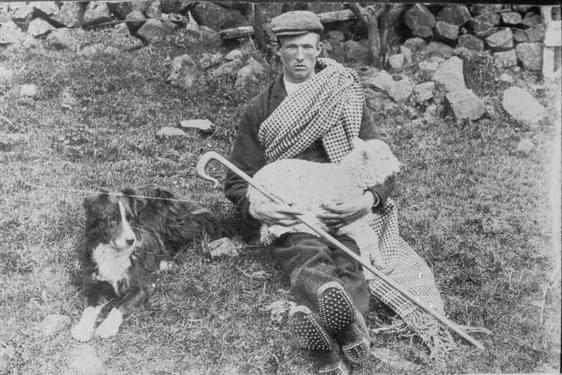
9 summer customs in rural Scotland
News Story
Summer on the farm involves a variety of different tasks from irrigation and harvesting to managing livestock.
Although autumn is usually associated with harvest, many crops on Scottish farms are gathered in the months of July and August. This includes cereal crops, soft fruit and even early crops of potatoes. Farmers make hay, and silage is a priority for feeding animals during the winter months.
June is the beginning of the summer show season. Agricultural shows are major events in the rural calendar. They celebrate livestock, farming, food, heritage and community. The Royal Highland Show at Ingliston is perhaps the biggest and best known as hundreds of thousands visit each year.
The Rural Life collections include tools, machinery, craft objects, paintings, and many more types of objects that tell stories of different seasons on farms and crofts. Here are several objects from National Museum of Rural Life that can tell us more about summer in rural Scotland.
1. Summer sheep shearing
Sheep shearing is a time-consuming but vital task on the farm. Shearing usually takes place in June, before the weather gets too hot, and is combined with many other treatments intended to keep sheep healthy.
To shear, sheep are placed on wooden sheep stools. Shearers then use spring-tined shears to remove the fleece. The person doing the shearing sits at the narrow end of the stool while the sheep were placed at the broader section. While few sheep stools have survived through the ages there are a handful in store at National Museum of Rural Life. This stool comes from Strachur in Argyll and is thought to have been made by a local in the 1930s.
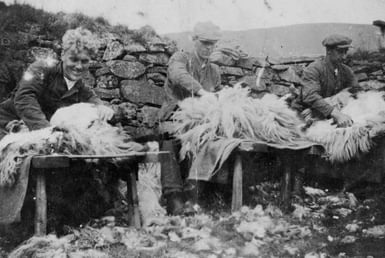
Sheep shearing possibly at Balquhidder in Perthshire, c.1920s. Museum reference: SLA C.5415 (Scottish Life Archive)
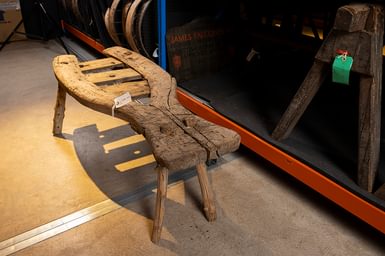
Sheep-clipping stool of redwood and whitewood, c.1930s. Museum reference: W.1990.243
2. Weddings and coggies
Throughout history, June has been a popular month for weddings. Marriage was a way of securing one’s future, but it was also cause for great celebration in rural communities.
Rural weddings would take place in the home or in the farm outbuildings and often involved the whole community. Betrothal and marriage were steeped in traditions and customs, many of which have local and regional variations and significance. Practices such as feet washing symbolised an act of cleansing. ‘Blackening’ involved covering the bride and groom in sticky substances before parading them in front of the community.
In Orkney, brides, grooms and their guests would drink from a bridal cog or coggie on wedding days. This coggie from Stromness, Orkney, is on display in the People Gallery at National Museum of Rural Life. It is made of wooden staves and has one lugged and two horn handles so that it could be carried around by both the bride and the groom who would have their guests to drink from it. The contents of the cog varied, but usually contained a blend of ale, spirits, sugar and spices.
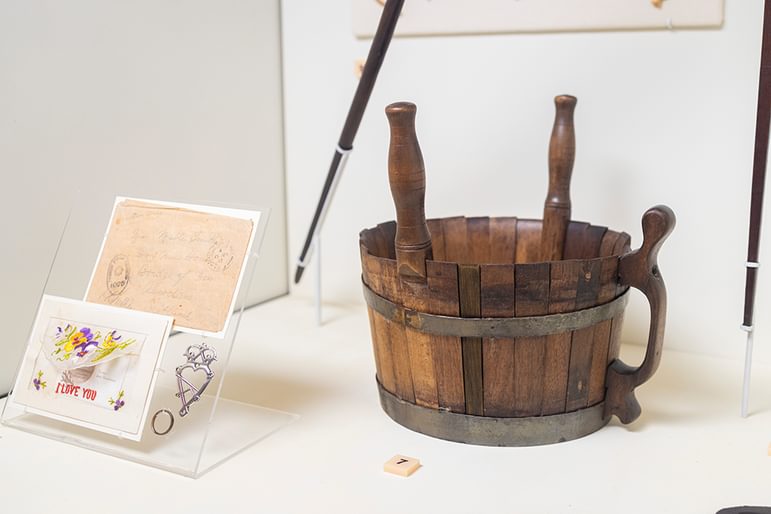
Bride’s coggie from Stromness, Orkney on display at National Museum of Rural Life. Museum reference: W.SFA 19.
3. Soft fruit and berry picking
Summer is berry picking season in Scotland. Scottish berries are favoured for their sweetness; a result of the cooler climate and long summer days that allows them to ripen more slowly.
The berry industry developed in parts of Scotland throughout the nineteenth century. Strawberries were being grown as a commercial crop by 1812. Raspberries were concentrated around Perthshire, particularly Blairgowrie, Angus and Fife. In the 1900s, Scotland’s fruit farms were bursting at the seams. Seasonal and often migrant labour were then required for an intense six-week period when the berries were ripe. Seasonal workers, including travellers, flocked to the country to be employed on the berry farms during the picking season in July and August. At the larger fruit farms, temporary huts, tents and facilities were set up to house the workers during peak season.
The punnet, a light basket or container used for fruit, has changed in design and materials over the last 100 years. Here are a few examples made from wood, card and plastic, dating from the 1930s through to the 1980s that are held at National Museum of Rural Life.

A selection of fruit punnets from the study store at National Museum of Rural Life.
4. Rope making
Rope was a commodity in high demand on farms, for rural trades and in the home. Rope was needed for tethering animals, thatching roofs, housebuilding and for drawing the plough in the field. It was also used extensively for fishing.
Most rope was made at home. Makers used organic materials such as heather, bent grass, rushes, straw and horsehair. Most of these materials were abundant in the summer months. They were made by hand often using rope twisters like these examples on display at National Museum of Rural Life.
Rope twisters varied in form and had different names depending where you were in the country, but were often known as thrawcocks. They consisted of a piece of wood with a swivelled hook at one end, to which the rope would be attached, and a cross piece at the other. Two people were usually required to operate the twister. One person turned the stick while the other stretched and fed the heather, rushes or straw to them.
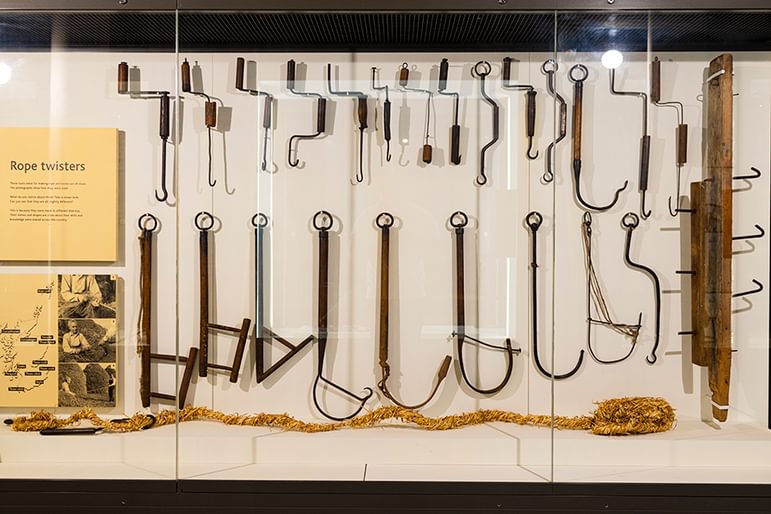
Rope twisters display at National Museum of Rural Life.
5. Fairs and agricultural shows
This photograph from the Scottish Life Archive depicts Highland cattle judging at the Royal Highland Show, Ingliston, in the 1930s.
The Highland Show is held every June by the Royal Highland and Agricultural Society of Scotland. It is the highlight of the agricultural calendar. Agricultural shows and fares have a long history in rural Scotland and were an important part of community life. Farmers competed with their livestock, crops and compared best practice. The shows were also a chance for women to showcase their own crafts and skills – 'in basketmaking, knitting, sewing, baking, cooking, and more.
The very first Highland Show was first held in 1822 in the grounds of Queensberry House, in Edinburgh’s Canongate. The show moved around and was held at different locations each year until 1960 when a permanent site was found at Ingliston Estate.
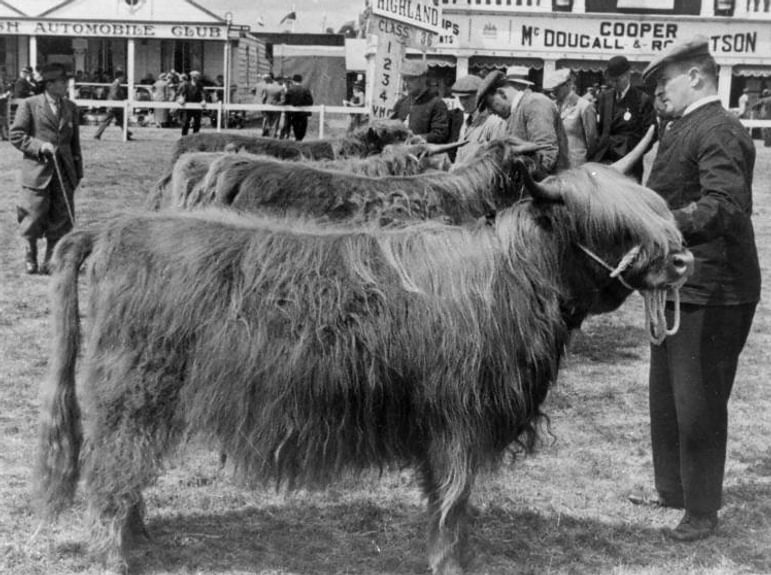
Cattle judging at the Royal Highland Show, Ingliston, Edinburgh, c.1930s. Museum reference: SLA.C.9182 (Scottish Life Archive)
6. Haymaking
Hay is made during the summer months. Hay is grass that is cut, turned and sun-dried to use as animal fodder during the winter months. It wasn’t until the late nineteenth century that hay began to be frequently made and used in Scotland. Hay was cut using sickles and scythes before mechanical horse-drawn mowers became popular in the 1850s.
Around the same time the double-tooth American hay rake, known as a ‘tummlin’ tam’ (or ‘tumbling tam’) was introduced to Scotland. It was horse-drawn and gathered dry hay into bundles with its six prongs before tumbling 360 degrees to start the process again. Hay bogeys, or hay rick lifters also helped speed up the process of haymaking.
Both of these implements came from Archbank farm in Moffat and are on display in the Tractor Store at National Museum of Rural Life.

7. Fishing for lobster
Lobster fishing is a seasonal activity that is at its peak in Scotland during June and July. There was a British market for Scottish lobster from the later eighteenth century.
Demand for lobster expanded dramatically in the nineteenth century. Between the 1860s and 1880s prices for lobster increased several times and the numbers of annual catches soared. It rose from around 600,000 in the 1880s to 900,000 in the 1930s and over 1.3 million in the 1940s. In the post-war period, the Scottish shellfish market widened further as improved methods of transporting live lobsters enabled international export.
Lobster creels were made of net and wood. The creels were weighted with stones, and bait was used to lure and trap the lobsters. Creels began being successfully used in the mid-nineteenth century all around Scottish coasts, with significant stocks in the west coast and in Orkney. The fisherman depicted in this photograph dated c.1930, Orkney, has a rather precarious pile of lobster creels piled in his small boat. Examples of lobster creels are stored at the National Museum of Rural Life.
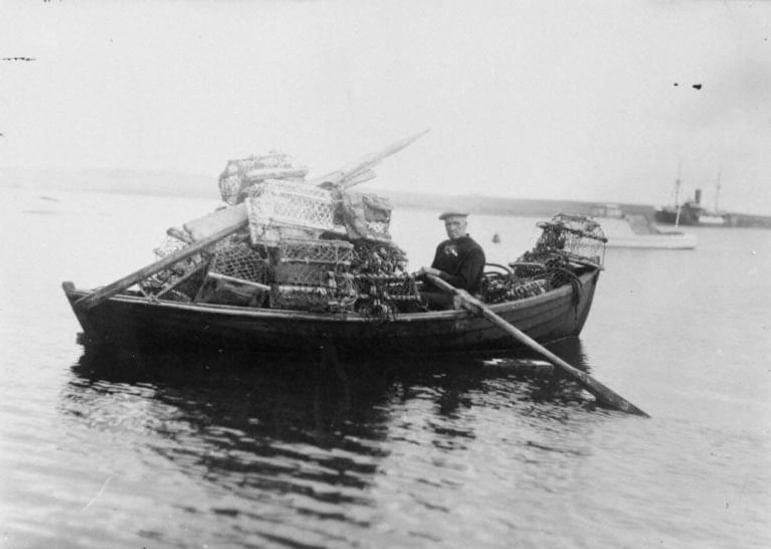
A lobster fisherman at the Orkney Islands, c.1930s. Museum reference: SLA.C.23752 (Scottish Life Archive)
8. The Glasgow tractor
Summer is a time of intense activity on farms, most of which would not be achievable today without tractors. While tasks used to be completed by teams of humans and animals, the introduction of the tractor in the twentieth century changed the face of farming forever. The use of the tractor could also produce higher yields for a changing post-war population.
National Museum of Rural Life has an impressive collections of tractors, including the ‘Glasgow’ tractor.
The Glasgow Tractor was made between 1919 and 1924 in Glasgow, making it one of the oldest tractors in the collection. It was the only tractor designed and manufactured in Scotland. It was better suited to Scotland’s muddy and rocky terrain than the popular imported American-made tractors, that were designed to be used on open and flat land. However, the Glasgow Tractor fell out of use due its expensive replacement parts. The tractor is on display in the Tools Gallery at National Museum of Rural Life.
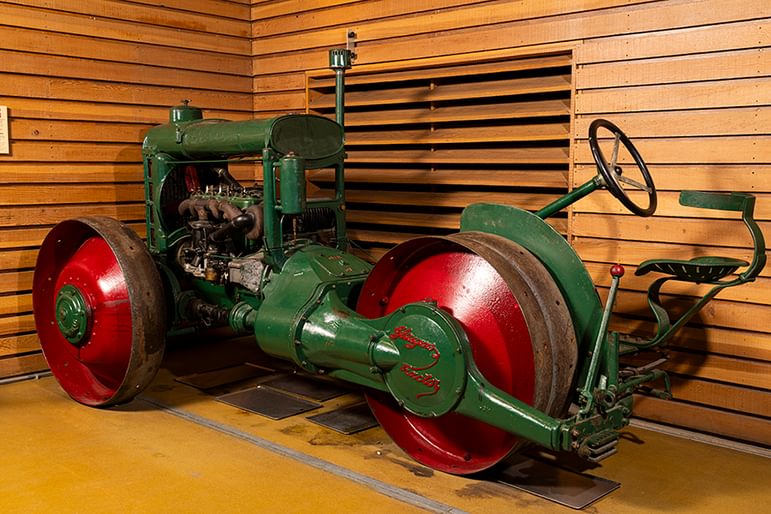
Wallace 'Glasgow' agricultural tractor on three steel wheels displayed indoors at Natural Museum of Rural life. Museum reference: W.1992.38
9. Summer harvesting
The combine harvester was introduced to Scotland in the 1930s, but it took until after the Second World War before they were widely used by farmers. There are 12 combine harvesters on display at National Museum of Rural Life.
The 726 model was manufactured in Kilmarnock, Scotland, by the Canadian company Massey Harris. It was first made in 1948-9 and was the first self-propelled combine to be produced in Europe. It has a narrow cutting head measuring only 8.5 feet and is powered by an Austin 6 cylinder, 4 litre petrol engine.
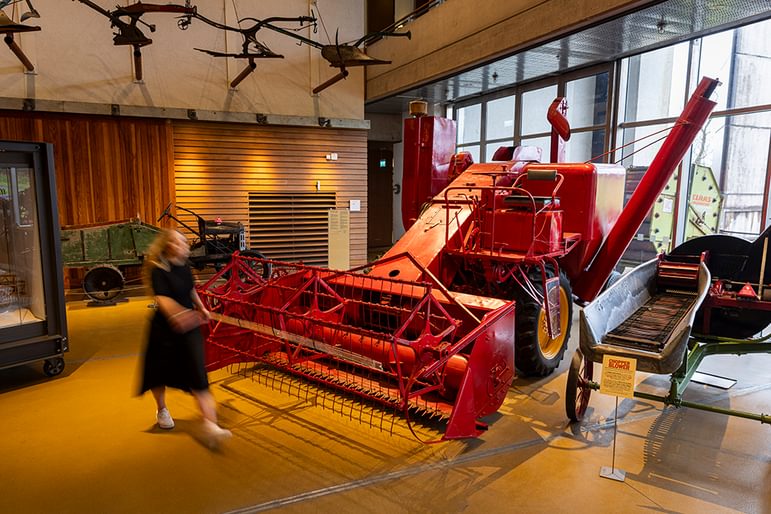
726 model combine harvester displayed indoors at the Natural Museum of Rural life. Museum reference: W.1999.21

